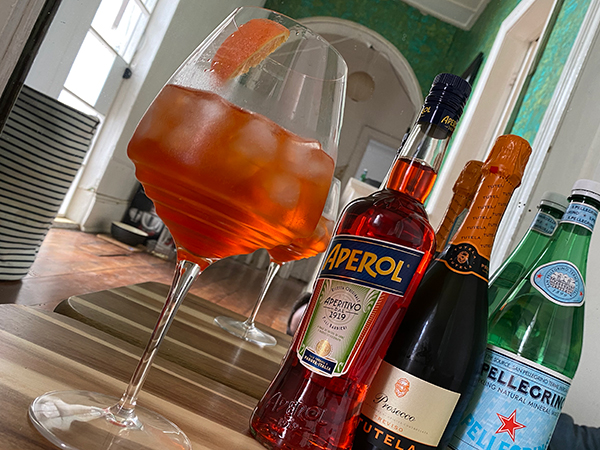Sydney Covid ‘lock-down’ exploration of the ‘Aperol Spritz’ cocktail, just in time for the warm weather!
Lockdown has inspired me to explore this popular cocktail. Let’s take a look at the classic ‘Aperol Spritz’, and explore some of its history.

APEROL SPRITZ
A very refreshing drink for social events and warm weather, and quite often someone’s first experience of a Cocktail.
Let’s give the ‘Aperol Spritz’ a 2021 ‘Locktail’ (Sydney Covid Lockdown) re-discovery, just in time for the warm Spring and Summer weather.
Make your own ‘mix-at-home’ Locktail, the ‘Aperol Spritz’.
INGREDIENTS
60ml Aperol
90ml Prosecco (or sparkling white)
30ml Soda Water (or mineral water)
Glassware – Wine Glass (or Goblet)
Preparation – Mix in Glass (with ice)
Ice – Cubes (fill glass with ice pieces)
Garnish – Orange Slice
Cost – $ (around AUD $5 ea)
Rating – ⭐⭐⭐ 3-stars (very good)
Lyle’s Rating – ⭐⭐⭐ 3-stars (average)
Mixed – 18 September 2021
Difficulty to Make – 🍸 (Very Easy)
LT Number – 030
Invented – around 1919 (by Barbieri Brothers)
Home – Padua, Italy
METHOD – Place a large amount of ice into a wine glass or glass goblet. Add 60ml Aperol, approximately 90ml of Prosecco or similar sparkling white wine or Champagne, and top with a splash (Spritz) of around 30ml of soda or mineral water. Garnish if you wish with an orange slice. Serve in the glass.
HISTORICAL NOTES – Aperol was created by Luigi and Silvio Barbieri in Pádova (Padua) in Northern Italy in 1919. The brothers inherited their Father’s liqueur company in 1912 and worked for 7-years to create an aperitif they felt represented the Pádova region, launching Aperol in 1919.
Spritz or ‘Spriss’, derived from the German word for ‘splash’, had been around in many forms, especially in Venice from the late 1800’s using soda water, and the new Aperol was an immediate match to the ‘spritz’ style of cocktail mix, although the ‘Aperol Spritz’ didn’t become commonplace and acquire an ‘official recipe’ until the 1950’s.
THE OFFICIAL MIX – The ‘Aperol Spritz’ is one of the International Bartender Association’s (IBA) ‘New Era Drinks’ list, here. The official recipe is as per the ingredients and method I have detailed above.
TASTING NOTES – Aperol is a ‘slightly bitter’ (far less than Campari for example) aperitif with strong citrus notes and colour. It matches extremely well with white wine, Prosecco and Champagne flavours and benefits from the carbonation (fizz or spritz).
Served cold, very cold, with lots of ice, this is a perfect drink for a warm day in the sun. It was one of my favorite drinks to enjoy during the heat of the Australian Open Tennis (in mid-Summer) and must have been for many others, as Aperol ran a very successful pop-up area, with large screens showing the Tennis, and only Aperol Spritz for very happy patrons.
LOCKTAIL CHANGES – I have not changed this recipe, other than for my first mix, enjoying it with Moët Champagne, left over from the preceding French 75 cocktail. The official mix from both IBA and Aperol themselves is exactly how most people enjoy an Aperol Spritz.
If you like something more bitter, you can change to Campari or a stronger bitters, or simply add some Regan’s or Angostura Orange Bitters. If you like sweeter, you can shift from a dry sparkling to a sweeter one, even to a sparkling Moscato (far too sweet for me).
The Aperol Spritz is in many ways an ‘on ramp’ for entry into the world of cocktails, and also, if you start really enjoying the bitter flavour, to ever more bitter cocktails such as the Negroni.
YOUR LOCKTAIL EXPERIENCE – If you’d rather taste than read, I am progressively building an ingredient list and other sourcing information on this site. I will re-use ingredients where I can (good for my budget too), so that the cost goes down overtime if you are ‘playing at home’.
Let me know what you think.
Cocktails you’d like reinvented.
Recipes you’ve tried and your ‘score’.
This is the final of the 10-cocktails in the 1911-1920 bracket of ‘Locktail’ remixes. Full list is in the index.
